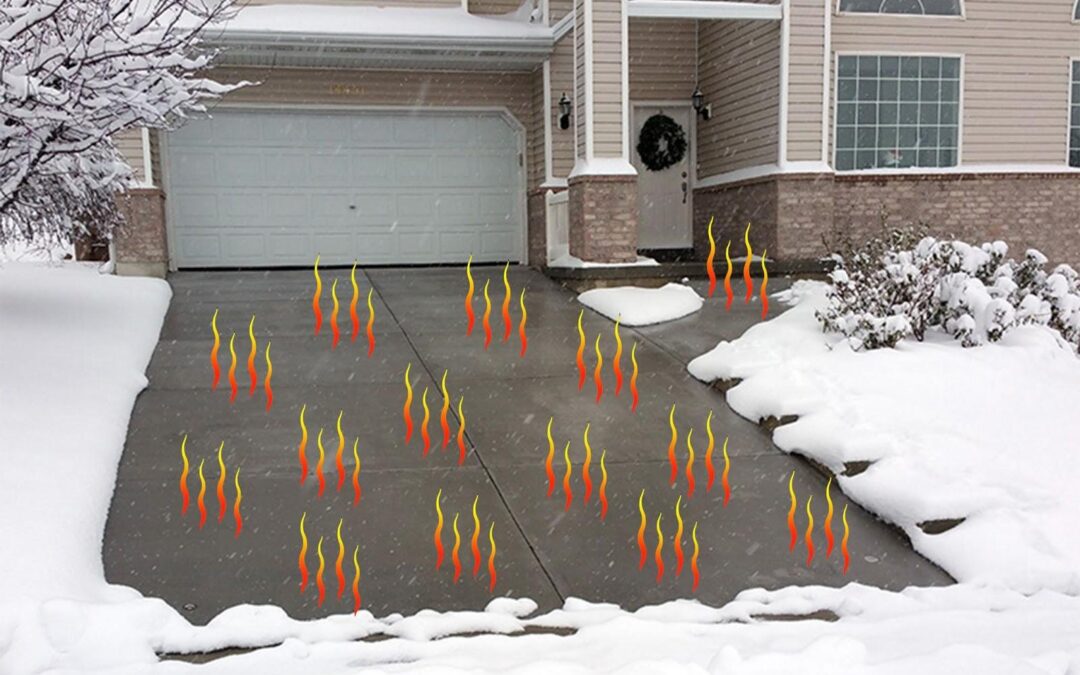Have you ever noticed the importance of caulking? Imagine what happens without using a caulk or using the wrong caulk! Gaps around windows, doors, and plumbing fixtures can allow water to seep into your home. Also, gaps and cracks in walls, windows, and doors can allow air to leak in and out of your home, reducing energy efficiency and increasing utility bills.
But with so many types of caulk on the market today, choosing which one to use can be confusing! If you are confused, you are not alone! Choosing the right one can feel overwhelming. Each type of caulk, from latex to silicone, serves a specific purpose, but how do you know which one to pick? Don’t worry; this guide will make it easy!
Types of Caulk
1. Acrylic Latex (Painter’s Caulk)
Acrylic latex caulk, or painter’s caulk, is a versatile and affordable caulk type for various home sealing needs. It’s perfect for DIY enthusiasts looking to seal joints, gaps, and cracks efficiently. However, remember to avoid using it in wet or outdoor environments, as it may not provide the required level of protection.
Pros
- Inexpensive and easy to use.
- Paintable after application.
- Cleans up easily with water.
- Suitable for various indoor projects.
- It dries in about an hour and is ready for painting.
- It can last 10 to 15 years under normal conditions.
Cons
- Not suitable for high-moisture areas like kitchens or bathrooms.
- Durability may be affected by exposure to moisture and sudden temperature changes.
- Not designed for outdoor use.
- Shrinkage
Where to Use
- Interior projects such as doors, windows, and trim sealing.
- Wood paneling installation.
- Quickly filling in small drywall holes and cracks.
- Sealing narrow gaps around interior doors, windows, baseboards, and crown molding.
Where Not to Use
- High-moisture areas like kitchens and bathrooms.
- Outdoor projects.
- Areas exposed to water.
Acrylic Latex Caulk: DAP Alex 10.1 oz. Painter’s All-Purpose Acrylic Latex Caulk
Figure 1: Acrylic Latex Caulk
2. Silicone
Silicone caulk is an excellent choice for specific sealing needs, offering durability and flexibility. Silicone is waterproof and more flexible than acrylic latex, a major plus when dealing with materials that expand and contract. Its features make silicone ideal for high-moisture environments like bathrooms and kitchens. While it excels in moisture-prone areas and exterior projects, it may only be suitable for some surfaces and interior applications. However, its ability to withstand harsh conditions and provide a long-lasting seal makes it a preferred option for many sealing projects.
Pros
- It is highly flexible and repels water and moisture effectively.
- Extremely durable, lasting up to 20 years.
- It withstands extreme temperature changes.
- Suitable for areas exposed to direct sunlight and rain.
- It provides a long-lasting seal when used outdoors.
- Paintable options are available for exterior projects.
Cons
- More expensive than latex caulk.
- Cleanup requires solvents instead of water.
- It does not adhere well to porous surfaces like wood, masonry, or drywall.
- Not paintable for interior projects.
Where to Use
- Where moisture exists, including kitchens and bathrooms.
- Exterior caulking for windows, doors, trim, and siding.
Figure 2: Where to use silicone caulk
Where Not to Use
- Porous surfaces like wood, masonry, or drywall.
- Projects where painting is required.
Silicone Caulk Suggestion: GE Advanced Silicone 2 Kitchen and Bath Sealant
Figure 3: Silicone Caulk
There are two types of silicone caulk available on the market. The first is acetoxy silicone, which contains acetic acid and emits a vinegar-like smell when used. This silicone caulk dries more quickly, but it can be corrosive to materials like natural stone and bituminous materials. The other type is neutral cure silicone. This type is not corrosive and more resistant for outdoor uses, but it requires 24 hours to dry and is slightly more expensive than the first type. Therefore, choose acetoxy silicone for indoor uses where fast-drying caulk is needed and with materials that can withstand an acidic environment. However, choose neutral cure silicone for outdoor projects where slower drying time and higher costs are acceptable and compatibility with any material is desired.
Siliconized Acrylic
Siliconized acrylic latex caulk is a mix of acrylic latex caulk and silicone. It offers a balance of flexibility, durability, and ease of use. Whether you’re sealing indoors or outdoors, this caulking solution provides a strong seal and easy application. However, it may not be as effective as pure silicone caulk in specific applications like high moisture areas.
Pros
- Improved adhesion, flexibility, and reduced shrinking compared to regular acrylic caulk.
- It combines the ease of use of acrylic with the strength of silicone.
- Available in a wide range of colors, including clear.
- Paintable.
- Easy to work with.
- Cleans up easily with water.
Cons
- Slightly more challenging to clean up compared to pure acrylic caulk.
- It is less effective than pure silicone caulk for high-moisture areas like bathrooms.
- There may be better choices for outdoor use despite being suitable.
Where to Use
- Porcelain, tile, metal, and glass surfaces.
- Indoor projects requiring moderate waterproofing, such as kitchen backsplashes.
- Outdoor sealing projects where flexibility and durability are needed.
Where Not to Use
- High-moisture areas.
Siliconized Acrylic Caulk Suggestion: DAP DYNAFLEX 230
Figure 4: Siliconized Acrylic Caulk
4. Polyurethane
Polyurethane caulk is the other caulk type, except for silicone caulk, which can be used in wet areas and outdoors. While it may not hold up as well as silicone caulk under intense sunlight, its flexibility and moisture resistance make it a reliable choice for many sealing projects.
Pros
- Moisture-resistant, making it suitable for outdoor use.
- Resistant to chemicals and corrosion.
- It provides excellent flexibility, resisting cracking and loosening during joint expansion and contraction.
- It adheres well to most surfaces, including wood.
- Paintable after application.
- Easier to clean up than silicone caulk.
- Dries hard once fully cured.
- It can last 5 to 10 years.
Cons
- It is less durable than silicone caulk in high sunlight exposure.
- It can be difficult to remove once dry.
Where to Use
- Outdoor projects such as gutter flashing and chimney sealing.
- Surfaces like siding, stone, and concrete.
- Wood or other surfaces that require painting.
Where Not to Use
- High sunlight exposure areas where silicone caulk would be more durable.
- On surfaces that may experience significant joint movement.
Polyurethane Caulk Suggestions:
2. DAP Premium Polyurethane Construction Adhesive Sealant
Figure 5: Polyurethane Caulk
5. Specialty Caulks
We have discussed the main types of caulk above, their features, and recommended usage. For any caulking project, you can choose one of the caulk types mentioned. However, manufacturers have also produced specialty caulks tailored for specific applications. These include fire-resistant caulk, vinyl caulk, butyl-rubber caulk, and more. Experience has shown that people may or may not find these specialty caulks useful. Let’s introduce some of the most common specialty caulk types:
1. Vinyl Latex
Vinyl latex caulk is a durable option that’s easy to apply and clean up, similar to painter’s caulk. It lasts longer than acrylic latex, making it a good choice for indoor and outdoor use. However, it’s less flexible, so it may not be suitable for areas with a lot of expansion and contraction. If you plan to use caulk outside, choose a vinyl latex caulk with a long lifespan for better durability. Specifically for outdoor applications, opt for vinyl latex caulk as it withstands various weather conditions.
2. Acrylic Tile Sealant
Tile acrylic caulk comes in small tubes you squeeze by hand, similar to toothpaste tubes. It’s handy for minor repairs and patches, especially in wet areas like bathrooms. While mold and mildew-resistant, it may not last long in high-use areas like tubs or showers. You can paint over it, and it’s easy to clean with soap and water. It usually stays flexible for a few years before needing replacement.
Figure 6: Acrylic Tile Sealant
3. Butyl-Rubber
Butyl-rubber is a caulk type specially made for outdoor use only. It’s a good choice for roofing construction and repairs because it can handle extreme temperatures and creates a strong, insulating, and watertight seal. It works best with aluminum, metal, concrete, mortar, plastics, rubber, stone, vinyl, and exterior wood. This caulk is excellent for gutters, flashing, siding, and concrete projects. Remember to wear protective gear, like gloves and eye protection, when using butyl rubber or roof caulk. These products can be irritating, and cleanup can be tricky if they get on your clothes, gloves, shoes, or skin.
Figure 7: Butyl-Rubber Caulk
4. Expandable Foam
Polyurethane spray foam sealant is applied through a narrow straw, expanding to fill more significant gaps and holes. It’s excellent for sealing and insulating and can even help dampen sound. This caulk type is sometimes used to fix foundations in old homes temporarily.
Expandable foam is ideal for sealing more significant gaps and holes around pipes, electrical outlets, and between window and door jambs.
Figure 8: Expandable Foam
5. Sanded Caulk
Sanded caulk is a type of sealant with tiny abrasive particles mixed in. These particles aid in adhesion to damp surfaces and fill more significant gaps without the risk of cracking. Its texture is grainy, making it most suitable for joints that are ⅛ inch or more wide. The primary use of sanded caulk is for repairing sanded grout lines between tiles.
Figure 9: Sanded Caulk
6. Fire Resistant Caulk
Fire Resistant Caulk, also known as firestop caulk or intumescent caulk, is designed to slow the spread of fire and smoke. When exposed to high heat, this caulk type expands to form a char barrier, sealing gaps and preventing flames and smoke from passing through. Different fireproof types of caulk have varying fire resistance ratings, usually 30 minutes to 4 hours. Its uses include sealing gaps and openings in walls, floors, ceilings, and around fire-rated doors to make buildings safer from fire.
Figure 10: Fire Resistant Caulk
IMPORTANT NOTE: Regarding specialty caulks, they are sometimes less effective than the labeling claims. So, check what these caulks are made of, such as silicone, acrylic latex, and others, and whether they are suitable for your intended application.
How to Choose the Proper Caulk Type?
As you have seen, so many different types of caulk are available on the market. Before you start searching, ask yourself the following questions, and then you know what to look for!
- How long do you want the caulk to last? A temporary project (like a school play prop) needs a different caulk than sealing your forever home.
- What are you sealing? Wood-to-wood needs a different caulk than metal-to-glass. Matching the right caulk to the materials is crucial.
- How significant are the gaps? Caulk is for small cracks, not large holes. Use a “backer rod” (like a foam spacer) for more significant gaps.
- Is it an outdoor or indoor project? Caulks used outdoors need to be UV and moisture-resistant.
- Do you want to paint the caulk or not? Not all caulks are paintable!
And always make sure to consult a professional!
Conclusion
Remember, caulk isn’t magic! All types of caulk are meant to seal small gaps, not giant holes. It also can’t replace grout or act as an adhesive. But when used correctly, it’s a powerful tool for keeping out water, air, noise, and bugs and making your home look finished and polished. Caulking is a crucial part of any construction and renovation project. Every professional contractor knows this, no matter how trivial it might seem, as we do at Matrix Construction! That’s why we wrote this article: to highlight the importance of using the proper caulk type.
If you are planning a home project in Philadelphia or New Jersey, feel free to contact us for help!
Lastly, we would love to hear about your experiences with caulk; what worked and what didn’t. Share your thoughts in the comments below!






![How to Get a Philadelphia EZ Deck Permit [2024]](https://matrixgc.com/wp-content/uploads/2022/07/Elevated-Deck-in-Philadelphia-Matrix-Construction-400x250.jpg)



0 Comments